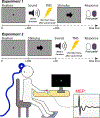Non-selective inhibition of the motor system following unexpected and expected infrequent events
- PMID: 32948892
- PMCID: PMC7717674
- DOI: 10.1007/s00221-020-05919-3
Non-selective inhibition of the motor system following unexpected and expected infrequent events
Abstract
Motor inhibition is a key control mechanism that allows humans to rapidly adapt their actions in response to environmental events. One of the hallmark signatures of rapidly exerted, reactive motor inhibition is the non-selective suppression of cortico-spinal excitability (CSE): unexpected sensory stimuli lead to a suppression of CSE across the entire motor system, even in muscles that are inactive. Theories suggest that this reflects a fast, automatic, and broad engagement of inhibitory control, which facilitates behavioral adaptations to unexpected changes in the sensory environment. However, it is an open question whether such non-selective CSE suppression is truly due to the unexpected nature of the sensory event, or whether it is sufficient for an event to be merely infrequent (but not unexpected). Here, we report data from two experiments in which human subjects experienced both unexpected and expected infrequent events during a two-alternative forced-choice reaction time task while CSE was measured from a task-unrelated muscle. We found that expected infrequent events can indeed produce non-selective CSE suppression-but only when they occur during movement initiation. In contrast, unexpected infrequent events produce non-selective CSE suppression relative to frequent, expected events even in the absence of movement initiation. Moreover, CSE suppression due to unexpected events occurs at shorter latencies compared to expected infrequent events. These findings demonstrate that unexpectedness and stimulus infrequency have qualitatively different suppressive effects on the motor system. They also have key implications for studies that seek to disentangle neural and psychological processes related to motor inhibition and stimulus detection.
Keywords: Cortico-motor excitability; Motor evoked potentials; Motor inhibition; Oddball; Surprise.
Conflict of interest statement
Figures


Similar articles
-
Perceptual Surprise Improves Action Stopping by Nonselectively Suppressing Motor Activity via a Neural Mechanism for Motor Inhibition.J Neurosci. 2018 Feb 7;38(6):1482-1492. doi: 10.1523/JNEUROSCI.3091-17.2017. Epub 2018 Jan 5. J Neurosci. 2018. PMID: 29305533 Free PMC article.
-
Common neural processes during action-stopping and infrequent stimulus detection: The frontocentral P3 as an index of generic motor inhibition.Int J Psychophysiol. 2021 May;163:11-21. doi: 10.1016/j.ijpsycho.2019.01.004. Epub 2019 Jan 17. Int J Psychophysiol. 2021. PMID: 30659867 Free PMC article.
-
Motor training strengthens corticospinal suppression during movement preparation.J Neurophysiol. 2020 Dec 1;124(6):1656-1666. doi: 10.1152/jn.00378.2020. Epub 2020 Sep 30. J Neurophysiol. 2020. PMID: 32997598
-
Age-related changes in corticospinal excitability and intracortical inhibition after upper extremity motor learning: a systematic review and meta-analysis.Neurobiol Aging. 2017 Jul;55:61-71. doi: 10.1016/j.neurobiolaging.2017.03.024. Epub 2017 Mar 27. Neurobiol Aging. 2017. PMID: 28431286
-
Inhibition for gain modulation in the motor system.Exp Brain Res. 2022 May;240(5):1295-1302. doi: 10.1007/s00221-022-06351-5. Epub 2022 Mar 26. Exp Brain Res. 2022. PMID: 35347346 Review.
Cited by
-
Examining motor evidence for the pause-then-cancel model of action-stopping: Insights from motor system physiology.bioRxiv [Preprint]. 2024 Jan 30:2024.01.30.577976. doi: 10.1101/2024.01.30.577976. bioRxiv. 2024. Update in: J Neurophysiol. 2024 Nov 1;132(5):1589-1607. doi: 10.1152/jn.00048.2024. PMID: 38352621 Free PMC article. Updated. Preprint.
-
Distraction by unexpected sounds: comparing response repetition and response switching.Front Psychol. 2024 Oct 2;15:1451008. doi: 10.3389/fpsyg.2024.1451008. eCollection 2024. Front Psychol. 2024. PMID: 39417033 Free PMC article.
-
β-Bursts over Frontal Cortex Track the Surprise of Unexpected Events in Auditory, Visual, and Tactile Modalities.J Cogn Neurosci. 2023 Mar 1;35(3):485-508. doi: 10.1162/jocn_a_01958. J Cogn Neurosci. 2023. PMID: 36603039 Free PMC article.
-
Examining motor evidence for the pause-then-cancel model of action-stopping: insights from motor system physiology.J Neurophysiol. 2024 Nov 1;132(5):1589-1607. doi: 10.1152/jn.00048.2024. Epub 2024 Oct 16. J Neurophysiol. 2024. PMID: 39412561
-
Restart errors reaction time of a two-step inhibition process account for the violation of the race model's independence in multi-effector selective stop signal task.Front Hum Neurosci. 2023 Feb 10;17:1106298. doi: 10.3389/fnhum.2023.1106298. eCollection 2023. Front Hum Neurosci. 2023. PMID: 36845879 Free PMC article.
References
-
- Aron AR, Robbins TW, & Poldrack RA (2014). Inhibition and the right inferior frontal cortex: one decade on. Trends in Cognitive Sciences, 18(4), 177–185. - PubMed
-
- Badry R, Mima T, Aso T, Nakatsuka M, Abe M, Fathi D, … & Fukuyama H (2009). Suppression of human cortico-motoneuronal excitability during the Stop-signal task. Clinical Neurophysiology, 120(9), 1717–1723. - PubMed
-
- Barker AT, Jalinous R, & Freeston IL (1985). Non-invasive magnetic stimulation of human motor cortex. The Lancet, 325(8437), 1106–1107. - PubMed
-
- Bestmann S, & Krakauer JW (2015). The uses and interpretations of the motor-evoked potential for understanding behaviour. Experimental Brain Research, 233(3), 679–689. - PubMed
MeSH terms
Grants and funding
LinkOut - more resources
Full Text Sources

